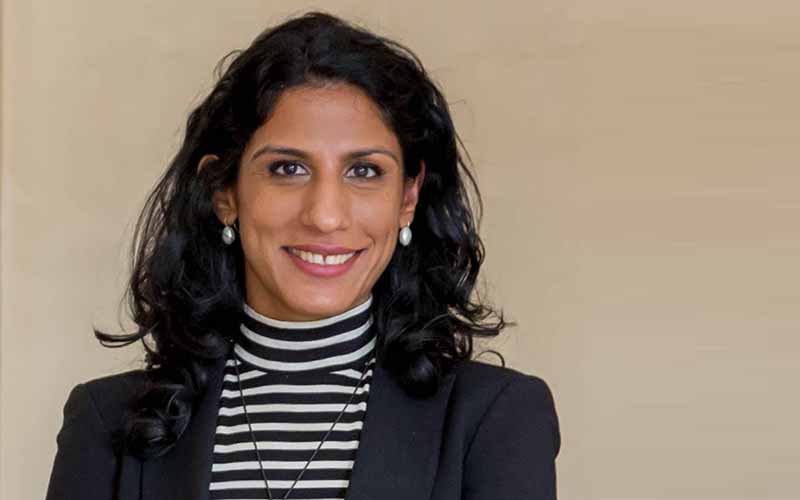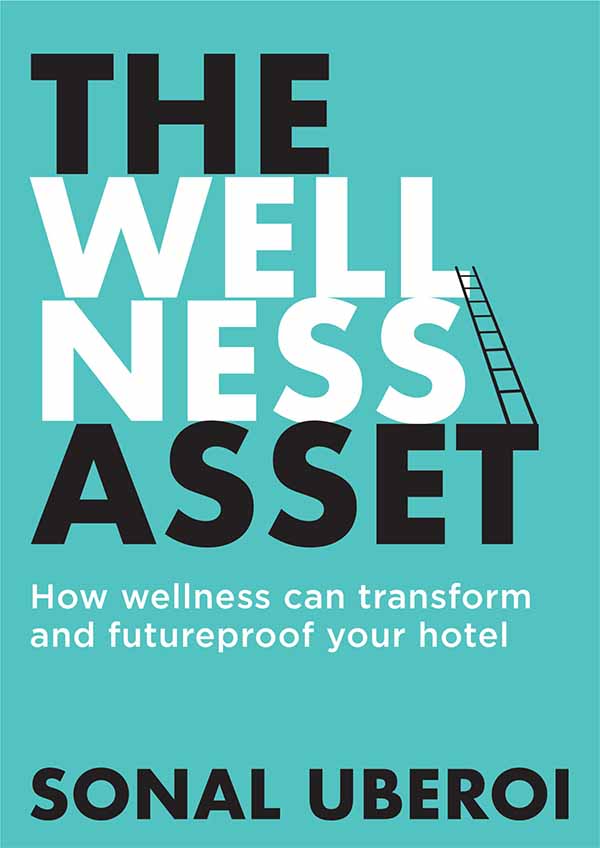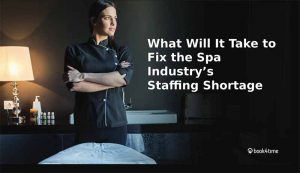
The Wellness Asset by global wellness expert Sonal Uberoi aims to show hospitality leaders how profitable wellness can be and how to build successful wellness offerings.
Sonal Uberoi is the founder of Spa Balance Consulting. Spas, hotel groups, and wellness companies hire Uberoi to help them design, set up, and manage their businesses.
She is the author of the book How to Open a Smart Spa and recently released her second book The Wellness Asset: How wellness can transform and future-proof your hotel.
The book aims to show hospitality leaders how profitable wellness can be and how to build successful wellness offerings using Uberoi’s ESSENCE Methodology.
We spoke with Uberoi about why she wrote this book and what’s happening in hospitality and wellness.
 What compelled you to write this book?
What compelled you to write this book?
We’re living unique times in the hospitality and wellness industries – industries that have essentially been built around the bricks-and-mortar business model. And we are at a crossroads. The old business model is broken, and the hoteliers and wellness professionals of the future know this. They aren’t sitting around waiting for the clock to turn back. They’re seizing this opportunity.
Whilst some brands are struggling, others are finding new ways to do what they’ve always done: serve their customers.
I wrote this book to show hoteliers, even the sceptical ones, that wellness does indeed make business sense. And no matter how urban or midscale your property is, incorporating wellness into it in a meaningful and coherent way will yield substantial dividends. I show them how as I walk them through my unique and carefully honed ESSENCE model.
How can the book be used to improve business operations?
This book is your go-to reference for wellness. It is your business playbook that contains the essential tools for you to do wellness successfully in any hotel (even when you leave your current hotel and move to another hotel).
To show you the true power of wellness to transform your hotel we need to take an accurate temperature reading of where your business is at right now before we start. We do this using my ESSENCE scorecard – a simple series of questions that I’ve carefully designed to give you the most meaningful “snapshot” of where you are and where your potential opportunities lie. It’s a great, free tool to learn more about your capability to create a wellness asset at this present moment.
In Part 1, we reframe your current view of wellness and show you some fallacies. In Part 2, we’ll learn the harsh truths of wellness in hospitality and how to work around them. In Part 3 the heavy lifting begins. I walk you through my proven ESSENCE model and guide you through the exercises I do with clients to build a profitable wellness asset.
I’ve also created a Wellness Business Essentials Toolkit which contains all the worksheets and templates you’ll need to work through each of the stages.
What is going wrong with wellness in hospitality?
Traditional hoteliers know that wellness is something they need to offer but they haven’t quite figured out how to tap into its full potential. They struggle to define their wellness offering in a way that makes them stand out from the competition and also makes them money without a sizable capital outlay and no return on investment.
The main areas traditional hoteliers struggle with when it comes to wellness are:
- Concept
They lack a clearly defined wellness concept, with little to no difference between one hotel’s wellness offering and the other’s next door. Their wellness facilities have grown organically over time and have been squeezed into any available space to maximise revenue per square metre.
- People
They lack the right expertise and people to do wellness properly in their hotels. They struggle to find qualified and experienced talent that their wellness profit and loss can sustain. They promote under-qualified staff to oversee their wellness operations, and as a result, these operations become a constant source of headache. - Performance
They ambitiously invest large sums in building grand facilities – for example, large hydrothermal areas, fully equipped spa suites, beautiful treatment rooms, state-of-the-art gyms, only to later find they have a heavily subsidised operation with high overheads and no return on investment.
People struggle with these areas because they’ve fallen victim to one or more of the myths of the common fallacies around wellness in hospitality: False Perceptions, False Economies and False Profits. Each of these fallacies is the result of a traditional mindset that has led hoteliers down unhelpful paths.
Can you elaborate on these “three fallacies”?
- False perceptions lead traditional hoteliers to mistakenly believe that wellness is not a lucrative option worth fully exploring. They either underinvest in their wellness offering, treat it as an amenity to their core business or stick to what they know best: selling rooms and food and beverage.
- False economies lead traditional hoteliers to stretch their resources too thin and think they’re saving money. The band-aid solutions of this short-term strategy cost the business much more than the original cost of proper investment, in the process alienating guests and denting the hotel’s image.
- False profits lead hoteliers to think they’re making more profits when, in reality, the gain in short-term profits comes at an opportunity cost in the long term. As a result, they fail to create a robust asset ecosystem because they focus on swift gains instead of solid and steady profits (the doomed “asset-light” approach).
How have guest expectations changed?
Wellness is the new luxury that today’s consumers are looking to our industry to provide as they pursue a state of wellbeing that allows for a fuller human experience than traditional hospitality typically provides.
It has become standard to find a spa and gym in five-star luxury hotels, but the market now demands increasingly more sophisticated, integrated wellness experiences.
Guests now crave a sense of connection from a hotel stay. People who are travelling less want to travel better and be nourished, healed, surprised and delighted, whatever their reason for travel – from before they arrive to during their stay and beyond.
What is a “hybrid model” and why is this important?
The hybrid model is the new buzzword, but it is here to stay – we’re seeing this across all sectors and it’s the product of the great disruption in today’s world. For example, hybrid meetings, hybrid workplaces, etc.
A hybrid model mixes two or more different elements. Making your treatment rooms multi-purpose, for example. Technology is nearly always associated with a hybrid model, but not all hybrid models necessarily involve technology, and adding technology doesn’t necessarily mean getting rid of human touch or personalised assistance – which most spa and wellness facilities fear losing. I actually look at technology as a powerful tool to help our therapists do remarkable work: more accurate diagnoses, evidence-based consultations, etc. We can’t hyper-personalise without technology, and technology helps us achieve consistent results by removing human error or subjective decision-making.
What are forward thinking hoteliers doing?
In the course of researching this book I have met some truly inspirational hoteliers. Passionate men and women who are leading the way, seeing wellness as a core part of hospitality.
These hoteliers of the future are pivoting, adapting and thriving by building and leveraging their wellness asset to enhance their guests’ overall experience in their hotel.
They understand that their guests’ needs have evolved and that today’s business and leisure travellers want more than the standard hotel room, decent breakfast and beautiful facilities. Today’s guests want experiences that are fulfilling, memorable and shareable; they want experiences that transform their overall wellbeing, even if in a simple way.
And these passionate men and women know that the only way they can transform their guests’ wellbeing is through the wellbeing of their teams and surrounding community. They attract people who think alike, and they get their teams excited about their vision and the positive impact of their meaningful work. They create a growth environment where wellness is at its core.
The hotelier of the future is forward-thinking, audacious and legacy-oriented, with a vision that stretches far beyond short-term profitability.
Buy the book at Amazon.com
 As the spa industry recovers to reclaim its former glory, and likely surpass it, there’s concern that businesses won’t be able to meet the demand because of a lack of staff. We spoke with some industry leaders to ask what spa and wellness can do to attract and retain talent. Click here to download the report.
As the spa industry recovers to reclaim its former glory, and likely surpass it, there’s concern that businesses won’t be able to meet the demand because of a lack of staff. We spoke with some industry leaders to ask what spa and wellness can do to attract and retain talent. Click here to download the report.
Spa Executive is published by Book4Time, the leader in guest management, revenue and mobile solutions for the most exclusive spas, hotels, and resorts around the globe. Learn more at book4time.com.



